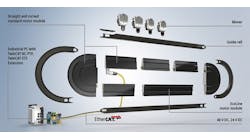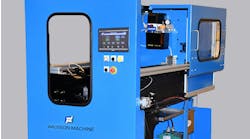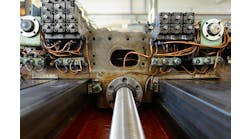In the world of machine controls, linear motion is the name given to the process of moving some object in a straight line, usually with a programmed speed and to a defined position. If a precise speed is not a requirement of the movement and the distance moved is between two constant points along the linear axis, one of the most straightforward linear-motion devices is a simple pneumatic cylinder.
Air, like any gas, is compressible. The pressure and flow of air into a pneumatic cylinder is controllable, but, if the load is not constant, or if the operating temperature changes or other environmental factors are not constant, the speed at which the cylinder reacts will change.
The travel distance of the pneumatic cylinder can be controlled with hard physical stops or the designed length of the cylinder’s pushrod.
When precise speeds and positions are required, pneumatic cylinders may not be the best choice. A better solution may be a device that includes a feed-screw component to produce the applied linear force required for movement, one or more linear bearings to maintain the straight line motion and a motor to drive the feed screw.
In addition to the mechanical components, the linear-motion control system may include control electronics to process movement commands into motor-control commands and sensors to provide position feedback to the control system. If the application requires the motion to be firmly held once the desired position is reached, a brake may be employed to prevent unwanted travel of the feed screw.
Feed-screw devices change the rotary motion of a motor into the desired linear motion. Two general types of feed-screw devices exist, although a significant amount of variation in design differences among different manufacturers also exists. A lead-screw style is, in effect, a threaded rod with a nut that moves parallel to the threaded rod axis as the threaded rod rotates. A ball screw is similar in operation; however, instead of the face of the screw and nut threads contacting each other, the ball screw uses ball bearings that reduce friction.
A lead screw has a much higher coefficient of friction than a ball screw. For lighter loads, cost efficiency favors a lead-screw-type device. For heavier loads, ball screws should be considered.
A linear-motion stage consists of a mounting base, a carriage or platform that holds the end effector, linear bearings (or bushings) and drive hardware—lead or ball screw, drive motor and motor controls.
Manufacturers can assist in selecting the best type of bearing style for the linear stage. Manufacturers will tend to specify solutions that use the products they sell, but their expertise can be utilized to narrow the field of choices.
Given the acceleration/deceleration rates, top speed, weight, distance of movement, duty cycle and desired life-span, manufacturers’ design tools will help to determine the most efficient designs. This includes selecting the correct type of linear bearing which is fundamental to a successful linear-stage application.
A drive motor and its controls are selected to complete the design of the motion stage. The motor power will be determined by the weight and direction of the load, along with the frictional drag of the bearings and screw mechanism and with the desired acceleration/deceleration rate.
If the required motion is a fixed speed and distance, a general purpose gear motor with or without a variable-frequency drive may be used to supply the rotational force to the threaded portion of the lead/ball screw. When the motion required is variable, a servo or stepper motor along with a motor-control system offers variable speed and positioning capabilities.
For a motion stage with two fixed positions, feedback signals may be simple proximity sensors. When the motion stage must move to variable positions, a linear position transducer or motor feedback is used to determine the actual position.
Servo- and stepper-motor controllers often offer an output that reflects the rotational movement of the motor. When the rotational output signal is multiplied by the pitch of the threaded rod, the assumed distance of movement for the linear-motion stage can be calculated. However, this calculation does not take into consideration feed-screw wear and backlash.





